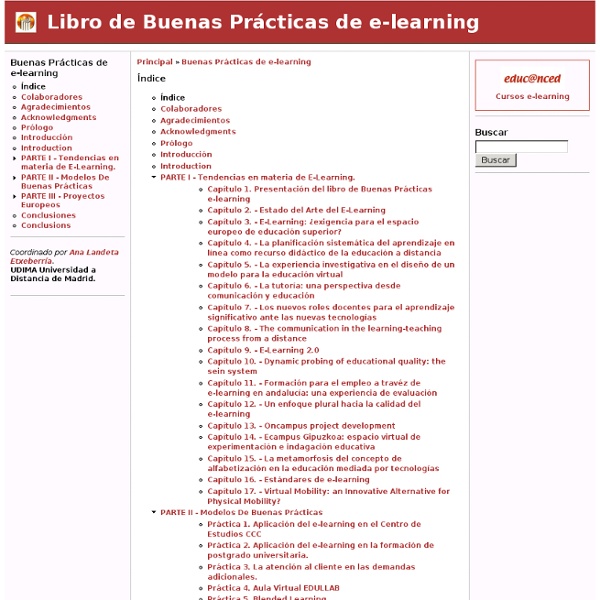



Más de 50 de las mejores herramientas online para profesores No es una exageración afirmar que hay ciento de aplicaciones educativas por ahí por la red, para todos los gustos y de todos los colores, por lo que es difícil tratar de recogerlas todas en un listado. Sin embargo, algunas destacan más que otras por su innovación y por su capacidad para conseguir adeptos, y esas son las que protagonizan la presente recopilación. Son 50 interesantes herramientas online basadas en las recopilaciones de EduArea, las muchas ya tratadas en Wwwhat’s new y las destacadas por la experiencia. 1. 11. 21. 31. 41. Aula al revés Los 10 principios de la nueva educación La primera ponencia del curso “Alfabetizaciones múltiples: una nueva ecología del aprendizaje” corre a cargo de Ferran Ruiz Tarragó. Ferran es docente y un reconocido especialista en el uso educativo de las TIC, además de ser actualmente el Presidente del Consejo Escolar de Cataluña y un bloguero activo en castellano y catalán. Personalmente recomendaría leer, entre muchos otros textos, la entrada “Mundo digital y escenarios de futuro de la educación“. Paso ahora a modo Twitter para narrar su ponencia: Comienza Ferran Ruiz Tarragó presentándose como docente, como gestor y como pensador y estableciendo los matices para que podamos contextualizar su presentación.Plantea como punto de partida la necesidad de “síntesis” en educación frente a la gran abundancia y diversidad de “análisis” con los que contamos: ¿viene el cambio a partir de la lectura de un análisis como PISA o de la síntesis personal y colectiva que hagamos de estos análisis?
Documentos Las destrezas específicamente las destrezas con criterios de desempeño necesitan para su verificación, indicadores esenciales de evaluación, la construcción de estos indicadores serán una gran preocupación al momento de aplicar la actualización curricular debido a la especificidad de las destrezas , esto sin mencionar los diversos instrumentos que deben ser variados por razones psicológicas y técnicas. ¿Qué son las destrezas con criterios de desempeño? ¿Cuál es la importancia?La Estructura Curricular 2010, propicia trabajar con destrezas con criterio de desempeño, esa es la orientación y como trabajadores de la educación, debemos aceptar y adaptarnos a esa orientación, más bien disposición. Esto nos lleva y obliga a la ampliación de nuestro conocimiento contestarnos ¿Qué son competencias? El apropiamiento de conceptos e ideas entre todos es fundamental y en el plano educativo es necesario asimilar las nociones elementales. Un Proceso para Evaluar Destrezas con criterio de desempeño
Utilización de las redes sociales en educación Juan José Pérez Tejedor. Curso Twitter en Educación. La verdad es que la utilización de las redes sociales en la educación abre un camino nuevo en la enseñanza, puesto que se han convertido en una nueva manera de enseñar y de aprender. Tuenti, Twitter, Linkedin, Google +, Edmodo, etc. son nombres que de ahora en adelante vamos a oír y en algunos casos manejar a menudo. Los profesores tenemos que darnos cuenta que el sistema ha cambiado, ya no somos nosotros, el libro y los alumnos, ahora hay un elemento más el exterior a nuestra aula. Todos tenemos un acceso inmediato e ilimitado a la información, y también tenemos un nuevo modo de comunicarnos, las redes sociales, tenemos Internet Podemos usarlas como medio de transmisión de conocimientos a nuestros alumnos, como medio de comunicación con padres, alumnos y demás miembros de la comunidad educativa y por eso creo que nuestro papel es fundamental, tenemos que usarlas y tenemos que usarlas de manera correcta.
La construcción colaborativa de proyectos como metodología para adquirir competencias digitales Revista Comunicar. E-ISSN: 1988-3293 / ISSN: 1134-3478 Pérez, M., Romero, M. & Romeu, T. (2014). La construcción colaborativa de proyectos como metodología para adquirir competencias digitales. Comunicar, 42, 15-24. Actualmente presenciamos una etapa de importantes cambios como consecuencia de la emergencia de las tecnologías de la información y la comunicación (TIC). Entre éstas, las vinculadas a las TIC y los procesos de colaboración se consideran claves. Para ello, se aborda el planteamiento metodológico de la asignatura «Competencias TIC» de la Universitat Oberta de Catalunya, la cual se desarrolla a través de un proyecto colaborativo en red organizado en cuatro fases: inicio, estructuración, desarrollo y conclusión y cierre. Mediante una investigación evaluativa se triangulan datos de naturaleza cuantitativa y cualitativa provenientes de un cuestionario. Abstract Descriptores Keywords Acceder 2 de enero de 2014